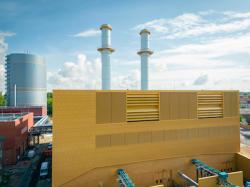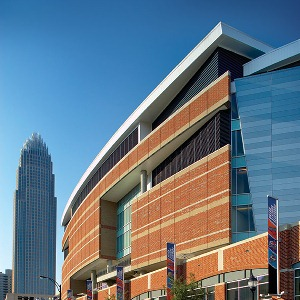CONSTRUCTION SPECIALTIES - LOUVRES
Suppliers of: Louvres and screens
Construction Specialties (CS) is a global manufacturer and supplier of specialist building products for the healthcare, education, commercial, retail, leisure and industrial sectors. The company collaborates closely with architects, interior designers, contractors and end users, offering comprehensive project support.
CS product ranges include wall protection solutions, impact resistant doors, entrance matting, expansion joint covers, architectural louvres, explosion venting and solar shading.
CS Louvres
CS have been manufacturing and selling louvres globally for over 60 years and has introduced many innovations to the market. All rain defence and ventilation louvres offered are independently tested and classified in accordance with global building standards. In addition, the company has its own louvre testing chamber to ensure any custom solutions meet performance requirments.
The range includes:
Rain Defence Louvres
Weather louvres allow the passage of air, whilst resisting wind-driven rain ingress. They are typically used where high levels of ventilation and maximum protection from the rain is needed, for instance when sensitive HVAC equipment is located close to the louvres.
CS Rain Defence Louvres are available in horizontal or vertical blade configurations, can be hidden behind attractive perforated screens or can feature varying blade depths, allowing them to become a stand-out element of the facade.
Most models are delivered to site as prefabricated modules for efficient installation. Optional perimeter glazing frames are also available for easy integration into curtain walling.
Ventilation Louvres
Designed to maximise airflow, CS Ventilation Louvres are typically specified for areas where occasional rain penetration is not an issue, but economy is a consideration. Modular options and continuous line variants which are assembled on-site are available, to suit project needs.
Screening Louvres
CS Screening louvres are a simple to install and economical solution for visual screening of plant or other equipment in locations where rain penetration is not a concern.
Acoustic Louvres
Where both noise control and airflow are required. CS Acoustic Louvres can be installed as standalone screens, or can be integrated into building facades. They can also be used in conjunction with any of the rain defence, ventilation or screening options, if needed.
Other Products Available from Construction Specialties:
CONSTRUCTION SPECIALTIES - ENTRANCE MATTING
CONSTRUCTION SPECIALTIES - EXPANSION JOINT COVERS
CONSTRUCTION SPECIALTIES - EXPLOSION VENTING
CONSTRUCTION SPECIALTIES - SOLAR SHADING
CONSTRUCTION SPECIALTIES - WALL PROTECTION
CS Louvres : Engineered for Efficiency Power, Ventilation & Rain Protection
 The new Leipzig South Combined Heat and Power (CHP) Plant is setting a benchmark for sustainable energy infrastructure in Germany. As part of this forward-looking project, Construction Specialties (CS) supplied high-performance Rain Defence Louvres to ensure efficient airflow and protection—without compromising on design.
The new Leipzig South Combined Heat and Power (CHP) Plant is setting a benchmark for sustainable energy infrastructure in Germany. As part of this forward-looking project, Construction Specialties (CS) supplied high-performance Rain Defence Louvres to ensure efficient airflow and protection—without compromising on design.
About the Project
Built on the site of the historic Ernst Thälmann power station, the plant combines cutting-edge Siemens gas turbines with advanced emissions-reducing technology. With over 93% efficiency, it provides both electricity and district heating to Leipzig—all while meeting strict environmental standards.
The Challenge
To maintain both functionality and aesthetics, the plant required a ventilation solution that could deliver reliable airflow, defend against wind-driven rain, and visually integrate across different parts of the facility.
The CS Solution
CS supplied its RSH-5700AL Rain Defence Louvres, tested to EN 13030 and achieving Class A rain protection at up to 3.0 m/s. A total of 245 m² of louvres were installed across the Main Power Plant, Gas Supply Facility, and Pump House—delivering consistent performance in both intake and exhaust applications.
Seamless integration
The project involved close collaboration with planners and architects to ensure a consistent aesthetic and optimal performance. The louvres were finished in various RAL colours to match each building’s design, helping unify the visual identity of the facility.
Completed in October 2023, the Leipzig South CHP Plant now plays a key role in expanding the city’s district heating network—powered by smart design and reliable ventilation from CS.
For further project information on the project visit: https://www.c-sgroup.co.uk/blog/leipzig-south-combined-heat-and-power-plant-leipzig-germany/
CS Louvres - How Weather Louvres Work
 When it comes to building design, incorporating effective ventilation systems is crucial for ensuring optimal airflow while preventing the ingress of rainwater. This is where weather louvres come into play. These innovative architectural elements not only enhance the aesthetics of a structure but also play a vital role in controlling airflow and protecting against rain intrusion. In this blog post, we will delve into the workings of weather louvres, focusing specifically on their ability to defend against rain.
When it comes to building design, incorporating effective ventilation systems is crucial for ensuring optimal airflow while preventing the ingress of rainwater. This is where weather louvres come into play. These innovative architectural elements not only enhance the aesthetics of a structure but also play a vital role in controlling airflow and protecting against rain intrusion. In this blog post, we will delve into the workings of weather louvres, focusing specifically on their ability to defend against rain.
The fundamental principle behind the rain defence capability of weather louvres lies in the shape of their blades.
As air enters the louvre, it encounters a series of specially designed blades that force it to change direction rapidly.
This abrupt change in airflow direction creates areas of low and high pressure, leading to the formation of low-pressure vortex turbulence.
The low-pressure areas generated by the turbulent airflow within the louvre play a crucial role in preventing rainwater from entering the structure.
Water Droplet Collection and Redirection:
As the air moves through the louvre, water droplets present in the incoming airflow are effectively thrown out into these low-pressure zones.
The droplets are then collected within the channels present in the louvre blades.
Once collected, the water is redirected horizontally along the blades towards the jambs and mullions of the louvre.
This horizontal redirection ensures that the water remains within the louvre system, minimising the risk of it entering the building.
The Importance of Effective Drainage:
While the ability to collect water is a vital aspect of weather louvres, it is equally important to ensure effective drainage. This is particularly crucial for larger width panels where a substantial amount of rainwater may be accumulated. If water is not efficiently drained away, there is a risk of it cascading down the louvre face and being re-entrained into the inlet airflow.
To avoid such scenarios, high-performance weather or rain defence louvres should be equipped with robust drainage systems. This typically enables collected water to be drained vertically down the jambs and mullions, allowing it to flow onto the cill and out of the building. These channels are designed to efficiently divert collected water towards designated outlets, preventing any possibility of water re-entering the ventilation system.
Weather Louvre Testing:
The standard performance test for weather louvres in Europe is EN 13030:2001 ‘Ventilation for buildings — Terminals — Performance testing of louvres subjected to simulated rain’.
The test results enable specifiers to directly compare the performance of different rain defence louvre models. A single louvre design classification should be accompanied by the limiting core velocity, e.g. Class A 2 up to 2m/s.








